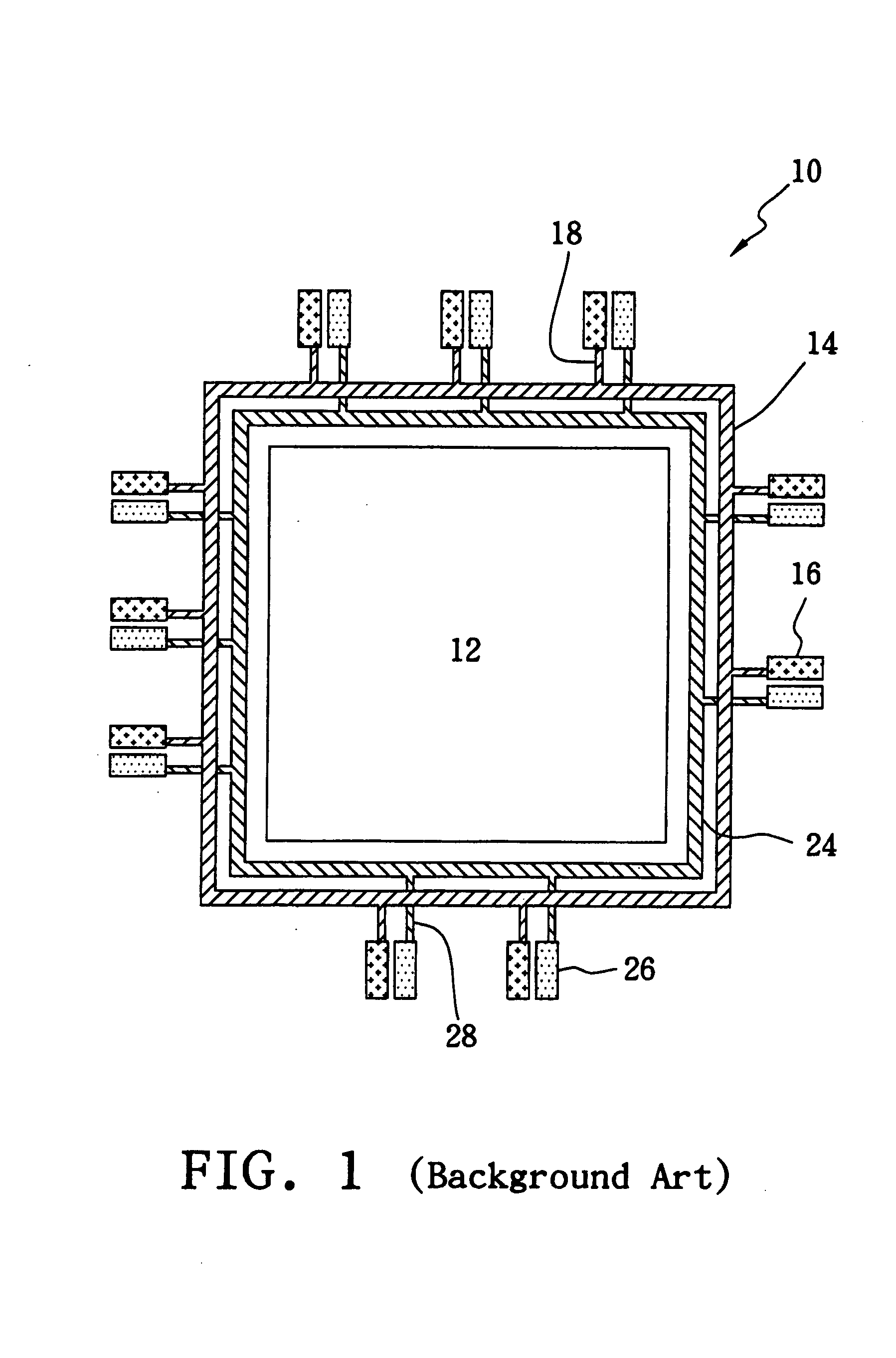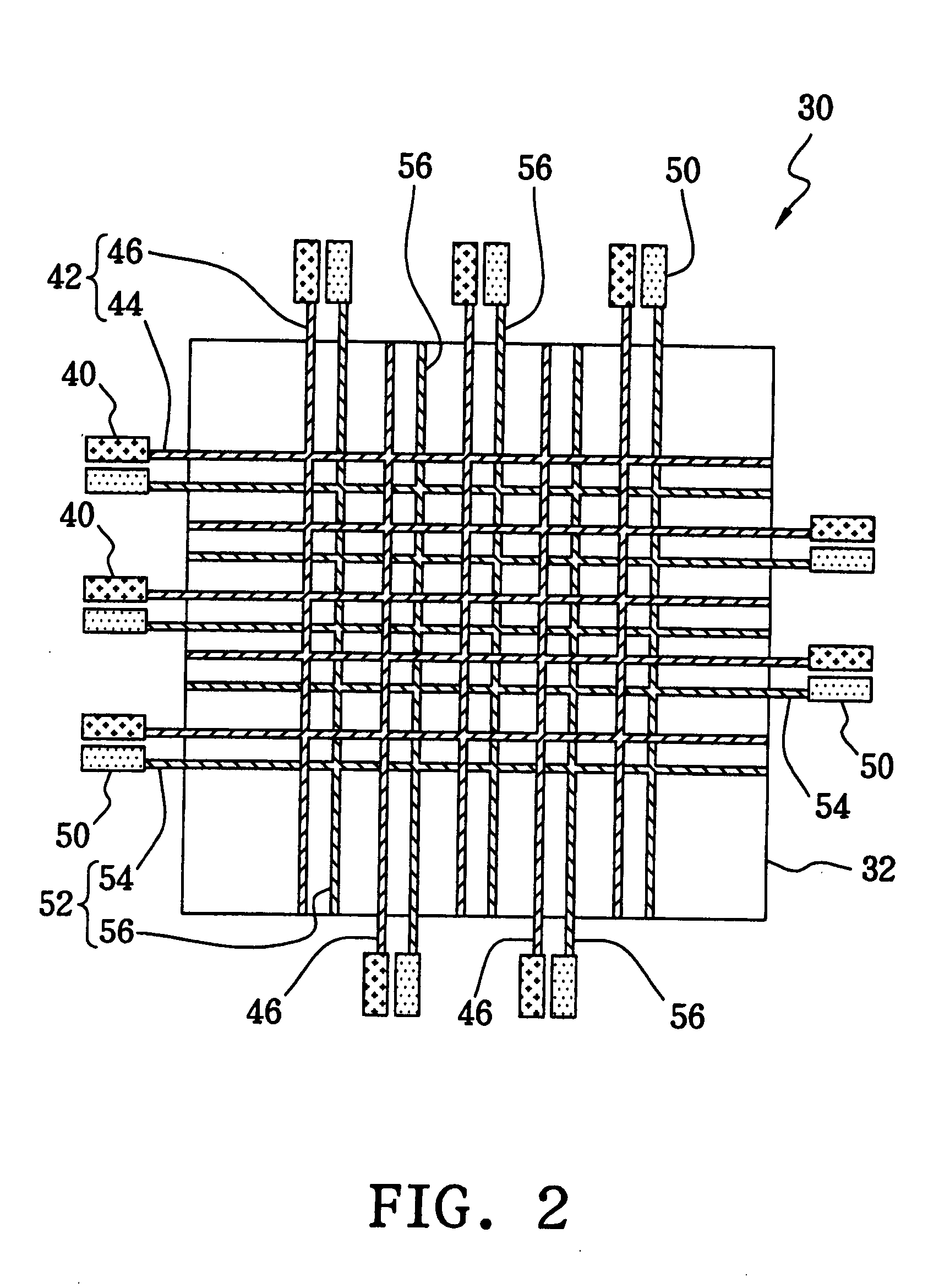Power supply layout for an integrated circuit
a power supply layout and integrated circuit technology, applied in the direction of semiconductor devices, semiconductor/solid-state device details, instruments, etc., can solve the problems of time delay originating from the capacitance and the resistance of the interconnection, voltage drop that decreases the real voltage supplied, high-performance circuits, etc., to simplify the design work of the integrated circuit
- Summary
- Abstract
- Description
- Claims
- Application Information
AI Technical Summary
Benefits of technology
Problems solved by technology
Method used
Image
Examples
first embodiment
[0025]FIG. 2 is a schematic diagram of an integrated circuit 30 according to the present invention. As shown in FIG. 2, the integrated circuit 30 comprises a plurality of power pads 40, a plurality of ground pads 50, a plurality of first-type conductive wires 42 directly connected to the power pad 40, a plurality of second-type conductive wires 52 directly connected to the ground pad 50, and a core circuit 32. The first-type conductive wire 42 is electrically connected to a positive potential, while the second-type conductive wires 52 is electrically connected to a ground potential. The integrated circuit 30 is made of a plurality of metal layers, and the first-type conductive wire 42 and the second-type conductive wire 52 are positioned at different metal layers. The power pad 40 and the first-type conductive wires 42 are positioned at the same metal layer, and the ground pads 50 and the second-type conductive wire 52 are positioned at the same metal layer.
[0026] The electronic com...
second embodiment
[0028]FIG. 3 is a schematic diagram of an integrated circuit 60 according to the present invention. Compared with the integrated circuit 30 in FIG. 2, the first-type conductive wire 42 and the power pad 40 of the integrated circuit 60 are positioned with different pitches between them, and both ends of first-type conductive wire 42 are electrically connected to the power pads 40 positioned around the core circuit 32 directly. Similarly, the second-type conductive wires 52 and the ground pads 50 are positioned with different pitches between them, and both ends of the second-type conductive wires 52 are electrically connected to the ground pads 50 directly.
[0029] If a certain region 62 of the core circuit 32 requires a higher power supply, the designer can arrange the power pads 40 and ground pads 50 more densely around the region 62 than the other regions, i.e., arrange the first-type conductive wires 42 and second-type conductive wires 52 more densely around the region 62. The volta...
third embodiment
[0030]FIG. 4 is a schematic diagram of an integrated circuit 90 according to the present invention. Compared with the integrated circuit 30 in FIG. 2, the integrated circuit 90 further comprises a plurality of first-type auxiliary wires 70, 72 and a plurality of second-type auxiliary wires 80,82. The first-type auxiliary wire 70 is positioned in parallel to the second wire 46, and the first-type auxiliary wire 72 is positioned in parallel to the first conductive wire 44. Neither of the ends of the first-type auxiliary wires 70,72 is connected to the power pad 40, but the first-type auxiliary wires 70,72 are electrically connected to the first wire 44 and the second wire 46, respectively, to maintain the positive potential. Similarly, neither of the ends of the second-type auxiliary wires 80, 82 is connected to the ground pad 50, but the second-type auxiliary wires 80,82 are electrically connected to the third wire 54 and the fourth wire 56, respectively, to maintain the ground poten...
PUM
 Login to View More
Login to View More Abstract
Description
Claims
Application Information
 Login to View More
Login to View More - R&D
- Intellectual Property
- Life Sciences
- Materials
- Tech Scout
- Unparalleled Data Quality
- Higher Quality Content
- 60% Fewer Hallucinations
Browse by: Latest US Patents, China's latest patents, Technical Efficacy Thesaurus, Application Domain, Technology Topic, Popular Technical Reports.
© 2025 PatSnap. All rights reserved.Legal|Privacy policy|Modern Slavery Act Transparency Statement|Sitemap|About US| Contact US: help@patsnap.com



